Infectious Salmon Anemia Virus Infectivity Is Determined by Multiple Segments with an Important Contribution from Segment 5
Abstract
:1. Introduction
2. Materials and Methods
2.1. Cell Culture
2.2. Generation of Reassortant Recombinant Viruses (rISAV)
2.3. rISAV Propagation in ASK Cells
2.4. RT-PCR and Sequencing
2.5. ISAV Detection by Indirect Immunofluorescence
2.6. Transmission Electron Microscopy (TEM)
2.7. Infection Kinetics
2.8. Cell Viability Assay
2.9. Plaque Assay
2.10. Early and Late Adsorption and Uptake Evaluation
2.11. IFN-α, Mx, and ISG15 Relative Quantitation
2.12. Computer Analysis
2.13. Statistical Analysis
3. Results
3.1. Rescue of Recombinant Reassortant ISA Virus
3.2. rISAV Infection in ASK Cells
3.3. Multiple Segments Determine ISAV Replicative Phenotype
3.4. Multiple Segments Determine the Host Range of ISAV In Vitro
3.5. The Cytopathic Effect Induced by ISAV Is Highly Impacted by Segment 5 Genotype
3.6. Segment 5 Is Involved in the Late Steps of Virus Adsorption and Uptake
3.7. Recombinant Viruses Induce Distinct Cytokine Expression Profiles Depending on Their Genetic Composition
4. Discussion
Supplementary Materials
Author Contributions
Funding
Institutional Review Board Statement
Informed Consent Statement
Data Availability Statement
Acknowledgments
Conflicts of Interest
References
- Koren, C.; Nylund, A. Morphology and morphogenesis of infectious salmon anemia virus replicating in the endothelium of Atlantic salmon Salmo salar. Dis. Aquat. Org. 1997, 29, 99–109. [Google Scholar] [CrossRef]
- Markussen, T.; Jonassen, C.M.; Numanovic, S.; Braaen, S.; Hjortaas, M.; Nilsen, H.; Mjaaland, S. Evolutionary mechanisms involved in the virulence of infectious salmon anaemia virus (ISAV), a piscine orthomyxovirus. Virology 2008, 374, 515–527. [Google Scholar] [CrossRef] [PubMed] [Green Version]
- Cottet, L.; Rivas-Aravena, A.; Cortez-San Martin, M.; Sandino, A.M.; Spencer, E. Infectious salmon anemia virus-Genetics and pathogenesis. Virus Res. 2011, 155, 10–19. [Google Scholar] [CrossRef] [PubMed]
- Snow, M.; Ritchie, R.; Arnaud, O.; Villoing, S.; Aspehaug, V.; Cunningham, C. Isolation and characterisation of segment 1 of the infectious salmon anaemia virus genome. Virus Res. 2003, 92, 99–105. [Google Scholar] [CrossRef]
- Krossøy, B.; Hordvik, I.; Nilsen, F.; Nylund, A.; Endresen, C. The putative polymerase sequence of infectious salmon anemia virus suggests a new genus within the Orthomyxoviridae. J. Virol. 1999, 73, 2136–2142. [Google Scholar] [CrossRef] [Green Version]
- Ritchie, R.; Heppell, J.; Cook, M.; Jones, S.; Griffiths, S. Identification and characterization of segments 3 and 4 of the ISAV genome. Virus Genes 2001, 22, 289–297. [Google Scholar] [CrossRef]
- Chase, G.P.; Rameix-Welti, M.A.; Zvirbliene, A.; Zvirblis, G.; Götz, V.; Wolff, T.; Naffakh, N.; Schwemmle, M. Influenza virus ribonucleoprotein complexes gain preferential access to cellular export machinery through chromatin targeting. PLoS Patog. 2011, 7, e1002187. [Google Scholar] [CrossRef] [Green Version]
- Aspehaug, V.; Mikalsen, A.; Snow, M.; Biering, E.; Villoing, S. Characterization of the Infectious Salmon Anemia Virus Fusion Protein. J. Virol. 2005, 79, 12544–12553. [Google Scholar] [CrossRef] [Green Version]
- Müller, A.; Markussen, T.; Drabløs, F.; Gjøen, T.; Jørgensen, T.; Solem, S.T.; Mjaaland, S. Structural and functional analysis of the hemagglutinin-esterase of infectious salmon anaemia virus. Virus Res. 2010, 151, 131–141. [Google Scholar] [CrossRef]
- Biering, E.; Falk, K.; Hoel, E.; Thevarajan, J.; Joerink, M.; Nylund, A.; Endresen, C.; Krossøy, B. Segment 8 encodes a structural protein of infectious salmon anaemia virus (ISAV); the colinear transcript from Segment 7 probably encodes a non-structural or minor structural protein. Dis. Aquat. Org. 2002, 49, 117–122. [Google Scholar] [CrossRef] [Green Version]
- García-Rosado, E.; Markussen, T.; Kileng, Ø.; Baekkevold, E.S.; Robertsen, B.; Mjaaland, S.; Rimstad, E. Molecular and functional characterization of two infectious salmon anaemia virus (ISAV) proteins with type I interferon antagonizing activity. Virus Res. 2008, 133, 228–238. [Google Scholar] [CrossRef] [PubMed]
- O’Neill, R.E.; Talon, J.; Palese, P. The influenza virus NEP (NS2 protein) mediates the nuclear export of viral ribonucleoproteins. EMBO J. 1998, 17, 288–296. [Google Scholar] [CrossRef] [PubMed] [Green Version]
- Cottet, L.; Cortez-San Martin, M.; Tello, M.; Olivares, E.; Rivas-Aravena, A.; Vallejos, E.; Sandino, A.M.; Spencer, E. Bioinformatic Analysis of the Genome of Infectious Salmon Anemia Virus Associated with Outbreaks with High Mortality in Chile. J. Virol. 2010, 84, 11916–11928. [Google Scholar] [CrossRef] [PubMed] [Green Version]
- McBeath, A.; Fourrier, M.; Munro, E.; Falk, K.; Snow, M. Presence of a full-length highly polymorphic region (HPR) in the ISAV haemagglutinin-esterase does not affect the primary functions of receptor binding and esterase activity. Arch. Virol. 2011, 156, 2285–2289. [Google Scholar] [CrossRef]
- Godoy, M.G.; Kibenge, M.J.; Suarez, R.; Lazo, E.; Heisinger, A.; Aguinaga, J.; Bravo, D.; Mendoza, J.; Llegues, K.O.; Avendaño-Herrera, R.; et al. Infectious salmon anaemia virus (ISAV) in Chilean Atlantic salmon (Salmo salar) aquaculture: Emergence of low pathogenic ISAV-HPR0 and re-emergence of virulent ISAV-HPR∆: HPR3 and HPR14. Virol. J. 2013, 10, 344. [Google Scholar] [CrossRef] [Green Version]
- Christiansen, D.H.; McBeath, A.J.A.; Aamelfot, M.; Matejusova, I.; Fourrier, M.; White, P.; Petersen, P.E.; Falk, K. First field evidence of the evolution from a non-virulent HPR0 to a virulent HPR-deleted infectious salmon anaemia virus. J. Gen. Virol. 2017, 98, 595–606. [Google Scholar] [CrossRef]
- Godoy, M.G.; Suarez, R.; Lazo, E.S.; Llegues, K.O.; Kibenge, M.J.T.; Wang, Y.; Kibenge, F.S.B. Genetic analysis and comparative virulence of infectious salmon anemia virus (ISAV) types HPR7a and HPR7b from recent field outbreaks in Chile. Virol. J. 2014, 11, 214. [Google Scholar] [CrossRef] [Green Version]
- Fourrier, M.; Lester, K.; Thoen, E.; Mikalsen, A.; Evensen, Ø.; Falk, K.; Collet, B.; McBeath, A. Deletions in the highly polymorphic region (HPR) of infectious salmon anaemia virus HPR0 haemagglutinin-esterase enhance viral fusion and influence the interaction with the fusion protein. J. Gen. Virol. 2014, 95, 1015–1024. [Google Scholar] [CrossRef] [Green Version]
- Ojeda, N.; Cárdenas, C.; Marshall, S. Interaction of the Amino-Terminal Domain of the ISAV Fusion Protein with Cognate Cell Receptor. Pathogens 2020, 9, 416. [Google Scholar] [CrossRef]
- Cárdenas, C.; Ojeda, N.; Labra, Á.; Marshall, S.H. Molecular features associated with the adaptive evolution of Infectious Salmon Anemia Virus (ISAV) in Chile. Infect. Genet. Evol. 2019, 68, 203–211. [Google Scholar] [CrossRef]
- Fourrier, M.; Lester, K.; Markussen, T.; Falk, K.; Secombes, C.J.; McBeath, A.; Collet, B. Dual mutation events in the haemagglutinin-esterase and fusion protein from an infectious salmon anaemia virus HPR0 genotype promote viral fusion and activation by an ubiquitous host protease. PLoS ONE 2015, 10, e0142020. [Google Scholar] [CrossRef] [PubMed] [Green Version]
- Pappas, C.; Aguilar, P.V.; Basler, C.F.; Solórzano, A.; Zeng, H.; Perrone, L.A.; Palese, P.; García-Sastre, A.; Katz, J.M.; Tumpey, T.M. Single gene reassortants identify a critical role for PB1, HA, and NA in the high virulence of the 1918 pandemic influenza virus. Proc. Natl. Acad. Sci. USA 2008, 105, 3064–3069. [Google Scholar] [CrossRef] [PubMed] [Green Version]
- Wang, C.; Chen, J.; Tseng, Y.; Hsu, C.; Hung, Y.; Chen, S.; Wong, C. Glycans on influenza hemagglutinin affect receptor. Proc. Natl. Acad. Sci. USA 2009, 106, 18137–18142. [Google Scholar] [CrossRef] [PubMed] [Green Version]
- Galloway, S.E.; Reed, M.L.; Russell, C.J.; Steinhauer, D.A. Influenza HA Subtypes Demonstrate Divergent Phenotypes for Cleavage Activation and pH of Fusion: Implications for Host Range and Adaptation. PLoS Pathog. 2013, 9, e1003151. [Google Scholar] [CrossRef] [Green Version]
- Chen, W.; Calvo, P.A.; Malide, D.; Gibbs, J.; Schubert, U.; Bacik, I.; Basta, S.; O’Neill, R.; Schickli, J.; Palese, P.; et al. A novel influenza A virus mitochondrial protein that induces cell death. Nat. Med. 2001, 7, 1306–1312. [Google Scholar] [CrossRef]
- Gülsah, G.; Klingel, K.; Otte, A.; Thiele, S.; Hudjetz, B.; Arman-Kalcek, G.; Sauter, M.; Shmidt, T.; Rother, F.; Baumgarte, S.; et al. Differential use of importin-α isoforms governs cell tropism and host adaptation of influenza virus. Nat. Commun. 2011, 2, 119–128. [Google Scholar] [CrossRef]
- Zimmermann, P.; Manz, B.; Haller, O.; Schwemmle, M.; Kochs, G. The Viral Nucleoprotein Determines Mx Sensitivity of Influenza A Viruses. J. Virol. 2011, 85, 8133–8140. [Google Scholar] [CrossRef] [Green Version]
- Solorzano, A.; Webby, R.J.; Lager, K.M.; Janke, B.H.; Garcia-Sastre, A.; Richt, J.A. Mutations in the NS1 Protein of Swine Influenza Virus Impair Anti-Interferon Activity and Confer Attenuation in Pigs. J. Virol. 2005, 79, 7535–7543. [Google Scholar] [CrossRef] [Green Version]
- Toro-Ascuy, D.; Tambley, C.; Beltran, C.; Mascayano, C.; Sandoval, N.; Olivares, E.; Medina, R.; Spencer, E. Development of a reverse genetic system for infectious salmon anemia virus: Rescue of recombinant fluorescent virus by using salmon internal transcribed spacer region 1 as a novel promoter. Appl. Environ. Microbiol. 2015, 81, 1210–1224. [Google Scholar] [CrossRef] [Green Version]
- Cárdenas, M.; Galleguillos, C.; Acevedo, K.; Ananias, C.; Alarcón, J.; Michelson, S.; Toledo, J.; Montoya, M.; Meneses, C.; Castro-Nallar, E.; et al. Rapid sequence modification in the highly polymorphic region (HPR) of the hemagglutinin gene of the infectious salmon anemia virus (ISAV) suggests intra-segmental template switching recombination. J. Fish Dis. 2020, 43, 1483–1496. [Google Scholar] [CrossRef]
- Rivas-Aravena, A.; Vallejos-Vidal, E.; Cortez-San Martin, M.; Reyes-Lopez, F.; Tello, M.; Mora, P.; Sandino, A.; Spencer, E. Inhibitory Effect of a Nucleotide Analog on Infectious Salmon Anemia Virus. J. Virol. 2011, 85, 8037–8045. [Google Scholar] [CrossRef] [PubMed] [Green Version]
- Kibenge, F.S.B.; Lyaku, J.R.; Rainnie, D.; Hammell, K.L. Growth of infectious salmon anemia virus in CHSE-214 cells and evidence for phenotypic differences between virus strains. J. Gen. Virol. 2000, 81, 143–150. [Google Scholar] [CrossRef] [PubMed]
- Castillo-Cerda, M.T.; Cottet, L.; Toro-Ascuy, D.; Spencer, E.; Cortez-San Martín, M. Development of plaque assay for Chilean infectious salmon anaemia virus, application for virus purification and titration in salmon ASK cells. J. Fish Dis. 2014, 37, 989–995. [Google Scholar] [CrossRef] [PubMed]
- Jorgensen, S.; Kleveland, E.; Grimholt, U.; Gjoen, T. Validation of reference genes for real-time polymerase chain reaction studies in Atlantic salmon. Mar. Biotechnol. 2006, 8, 398–408.38. [Google Scholar] [CrossRef] [PubMed]
- Pfaffl, M.W. A new mathematical model for relative quantification in real-time RT–PCR. Nucleic Acids Res. 2001, 29, e45. [Google Scholar] [CrossRef]
- Reyes-Cerpa, S.; Reyes-López, F.; Toro-Ascuy, D.; Montero, R.; Maisey, K.; Acuña-Castillo, C.; Sunyer, O.; Parra, D.; Sandino, A.M.; Imarai, M. Induction of anti-inflammatory cytokine expression by IPNV in persistent infection. Fish. Shellfish. Immunol. 2014, 41, 172–182. [Google Scholar] [CrossRef]
- Haugland, Ø.; Torgersen, J.; Syed, M.; Evensen, Ø. Expression profiles of inflammatory and immune-related genes in Atlantic salmon (Salmo salar L.) at early time post vaccination. Vaccine 2005, 23, 5488–5499. [Google Scholar] [CrossRef]
- Mcbeath, A.; Aamelfot, M.; Christiansen, D.H.; Matejusova, I.; Markussen, T.; Kaldhusdal, M.; Dale, O.B.; Weli, S.C.; Falk, K. Immersion challenge with low and highly virulent infectious salmon anaemia virus reveals different pathogenesis in Atlantic salmon, Salmo salar L. J. Fish Dis. 2015, 38, 3–15. [Google Scholar] [CrossRef]
- Sernapesca. Informe Sanitario De Salmonicultura En Centros Marinos Año 2019. 2020; pp. 1–6. Available online:http://www.sernapesca.cl/sites/default/files/informe_sanitario_salmonicultura_2019_final_julio_2020.pdf (accessed on 1 December 2020).
- Bouchard, D.; Keleher, W.; Opitz, H.M.; Blake, S.; Edwards, K.C.; Nicholson, B.L. Isolation of infectious salmon anemia virus (ISAV) from Atlantic salmon in New Brunswick, Canada. Dis. Aquat. Org. 1999, 35, 131–137. [Google Scholar] [CrossRef]
- Kibenge, F.S.B.; Gárate, O.N.; Johnson, G.; Arriagada, R.; Kibenge, M.J.T.; Wadowska, D. Isolation and identification of infectious salmon anaemia virus (ISAV) from Coho salmon in Chile. Dis. Aquat. Org. 2001, 45, 9–18. [Google Scholar] [CrossRef] [Green Version]
- Aspehaug, V.; Falk, K.; Krossøy, B.; Thevarajan, J.; Sanders, L.; Moore, L.; Endresen, C.; Biering, E. Infectious salmon anemia virus (ISAV) genomic segment 3 encodes the viral nucleoprotein (NP), an RNA-binding protein with two monopartite nuclear localization signals (NLS). Virus Res. 2004, 106, 51–60. [Google Scholar] [CrossRef] [PubMed]
- Sun, W.; Li, J.; Han, P.; Yang, Y.; Kang, X.; Li, Y.; Li, J.; Zhang, Y.; Wu, X.; Jiang, T.; et al. U4 at the 3′ UTR of PB1 Segment of H5N1 Influenza Virus Promotes RNA Polymerase Activity and Contributes to Viral Pathogenicity. PLoS ONE 2014, 9, e93366. [Google Scholar]
- Rodriguez, P.; Marcos-Villar, L.; Zamarreño, N.; Yángüez, E.; Nieto, A. Mutations of the segment-specific nucleotides at the 3′end of influenza virus NS segment control viral replication. Virology 2020, 539, 104–113. [Google Scholar] [CrossRef] [PubMed]
- Li, X.; Chen, Y.; Wang, X.; Peng, B.; Wu, W.; Liu, H.; Sun, Y.; Tang, X.; Zheng, Q.; Fang, S. U13 → C13 mutation in the variable region of the NA gene 3′UTR of H9N2 influenza virus influences the replication and transcription of NA and enhances virus infectivity. Virus Genes 2019, 55, 440–447. [Google Scholar] [CrossRef] [PubMed]
- Fourrier, M.; Heuster, S.; Munro, E.; Snow, M. Characterization and comparison of the full 3′ and 5′untranslated genomic regions of diverse isolates of infectious salmon anemia virus by using a rapid and universal method. J. Virol. Methods 2011, 174, 136–143. [Google Scholar] [CrossRef] [PubMed]
- Wagner, R.; Wolff, T.; Herwig, A.; Pleschka, S.; Klenk, H.-D. Interdependence of Hemagglutinin Glycosylation and Neuraminidase as Regulators of Influenza Virus Growth: A Study by Reverse Genetics. J. Virol. 2000, 74, 6316–6323. [Google Scholar] [CrossRef] [Green Version]
- Medina, R.A.; Stertz, S.; Manicassamy, B.; Zimmermann, P.; Sun, X.; Albrecht, R.A.; Uusi-Kerttula, H.; Zagordi, O.; Belshe, R.B.; Frey, S.E. Glycosylations in the globular head of the hemagglutinin protein modulate the virulence and antigenic properties of the H1N1 influenza viruses. Sci. Transl. Med. 2013, 5, 23–37. [Google Scholar] [CrossRef] [Green Version]
- Akarsu, H.; Burmeister, W.P.; Petosa, C.; Petit, I.; Müller, C.W.; Ruigrok, R.W.H.; Baudin, F. Crystal structure of the M1 protein-binding domain of the influenza A virus nuclear export protein (NEP/NS2). EMBO J. 2003, 22, 4646–4655. [Google Scholar] [CrossRef]
- Brunotte, L.; Flies, J.; Bolte, H.; Reuther, P.; Vreede, F.; Schwemmle, M. The nuclear export protein of H5N1 influenza A viruses recruits Matrix 1 (M1) protein to the viral ribonucleoprotein to mediate nuclear export. J. Biol. Chem. 2014, 289, 20067–20077. [Google Scholar] [CrossRef] [Green Version]
- Iwatsuki-Horimoto, K.; Horimoto, T.; Fujii, Y.; Kawaoka, Y. Generation of Influenza A Virus NS2 (NEP) Mutants with an Altered Nuclear Export Signal Sequence. J. Virol. 2004, 78, 10149–10155. [Google Scholar] [CrossRef] [Green Version]
- Gülsah, G.; Herwig, A.; Klenk, H.D. Interaction of polymerase subunit PB2 and NP with importin α1 is a determinant of host range of influenza A virus. PLoS Pathog. 2008, 4, 231–242. [Google Scholar] [CrossRef]
- Boivin, S.; Hart, D.J. Interaction of the influenza A virus polymerase PB2 C-terminal region with importin α isoforms provides insights into host adaptation and polymerase assembly. J. Biol. Chem. 2011, 286, 10439–10448. [Google Scholar] [CrossRef] [PubMed] [Green Version]
- Joseph, T.; Cepica, A.; Brown, L.; Ikede, B.O.; Kibenge, F.S.B. Mechanism of cell death during infectious salmon anemia virus infection is cell type-specific. J. Gen. Virol. 2004, 85, 3027–3036. [Google Scholar] [CrossRef] [PubMed]
- Ohyama, K.; Nishina, M.; Yuan, B.; Bessho, T.; Yamakawa, T. Apoptosis induced by influenza virus-hemagglutinin stimulation may be related to fluctuation of cellular oxidative condition. Biol. Pharm. Bull. 2003, 26, 141–147. [Google Scholar] [CrossRef] [PubMed] [Green Version]
- Svingerud, T.; Holand, J.K.; Robertsen, B. Infectious salmon anemia virus (ISAV) replication is transiently inhibited by Atlantic salmon type I interferon in cell culture. Virus Res. 2013, 177, 163–170. [Google Scholar] [CrossRef] [PubMed] [Green Version]
- Chinsangaram, J.; Piccone, M.E.; Grubman, M.J. Ability of foot-and-mouth disease virus to form plaques in cell culture is associated with suppression of alpha/beta interferon. J. Virol. 1999, 73, 9891–9898. [Google Scholar] [CrossRef] [Green Version]
- Ditlecadet, D.; Gautreau, C.; Boston, L.; Liston, R.; Johnsen, E.; Gagné, N. First report of successful isolation of a HPR0-like variant of the infectious salmon anaemia virus (ISAV) using cell culture. J. Fish Dis. 2022, 45, 479–483. [Google Scholar] [CrossRef]

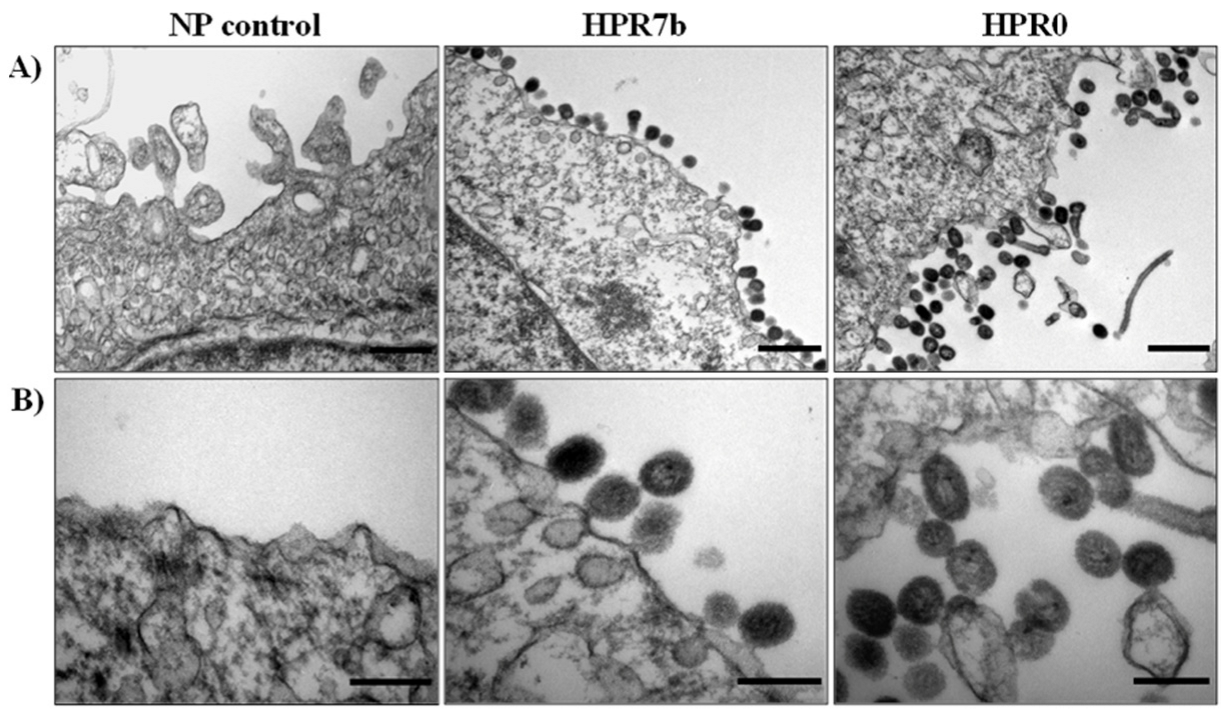
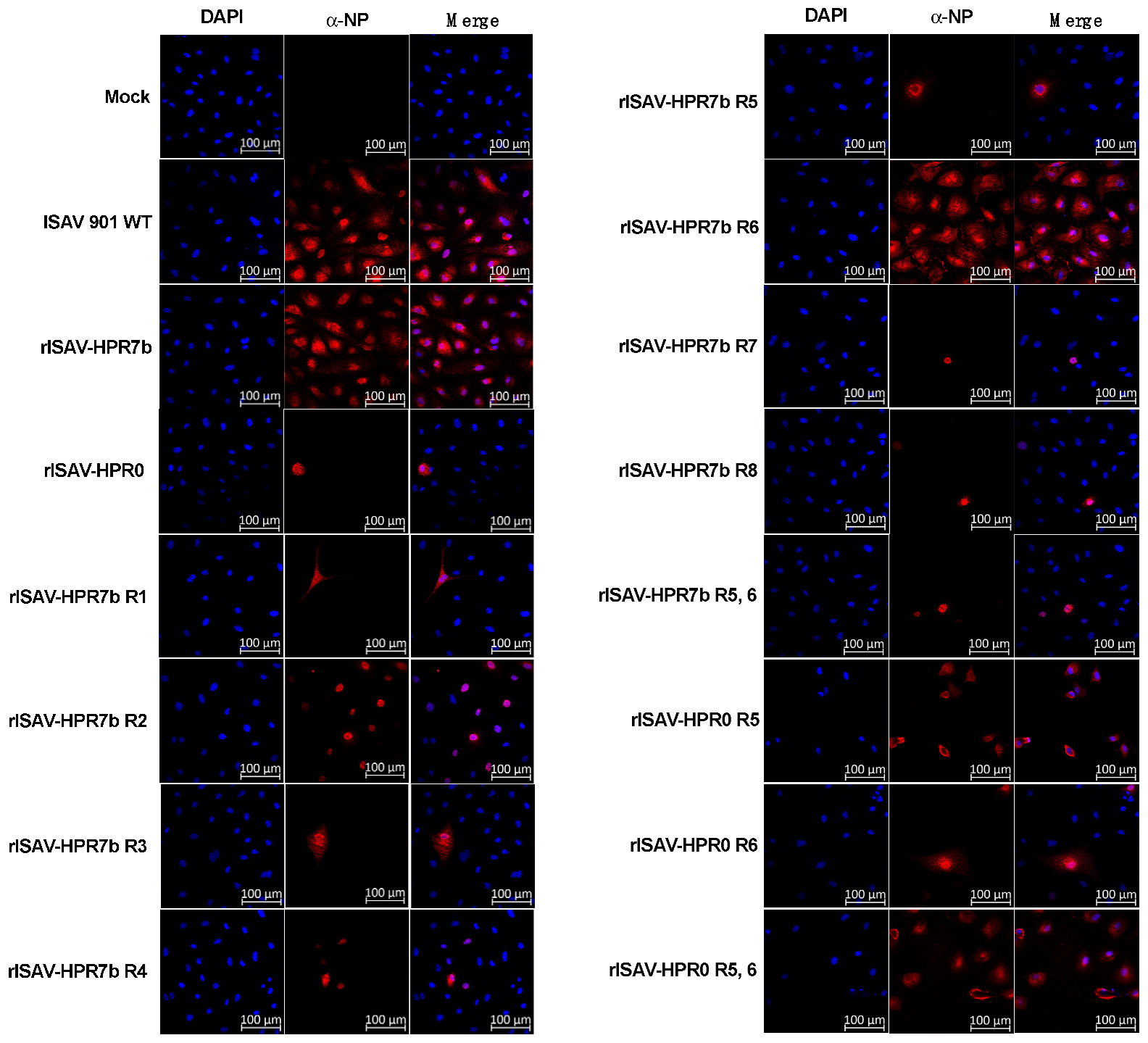
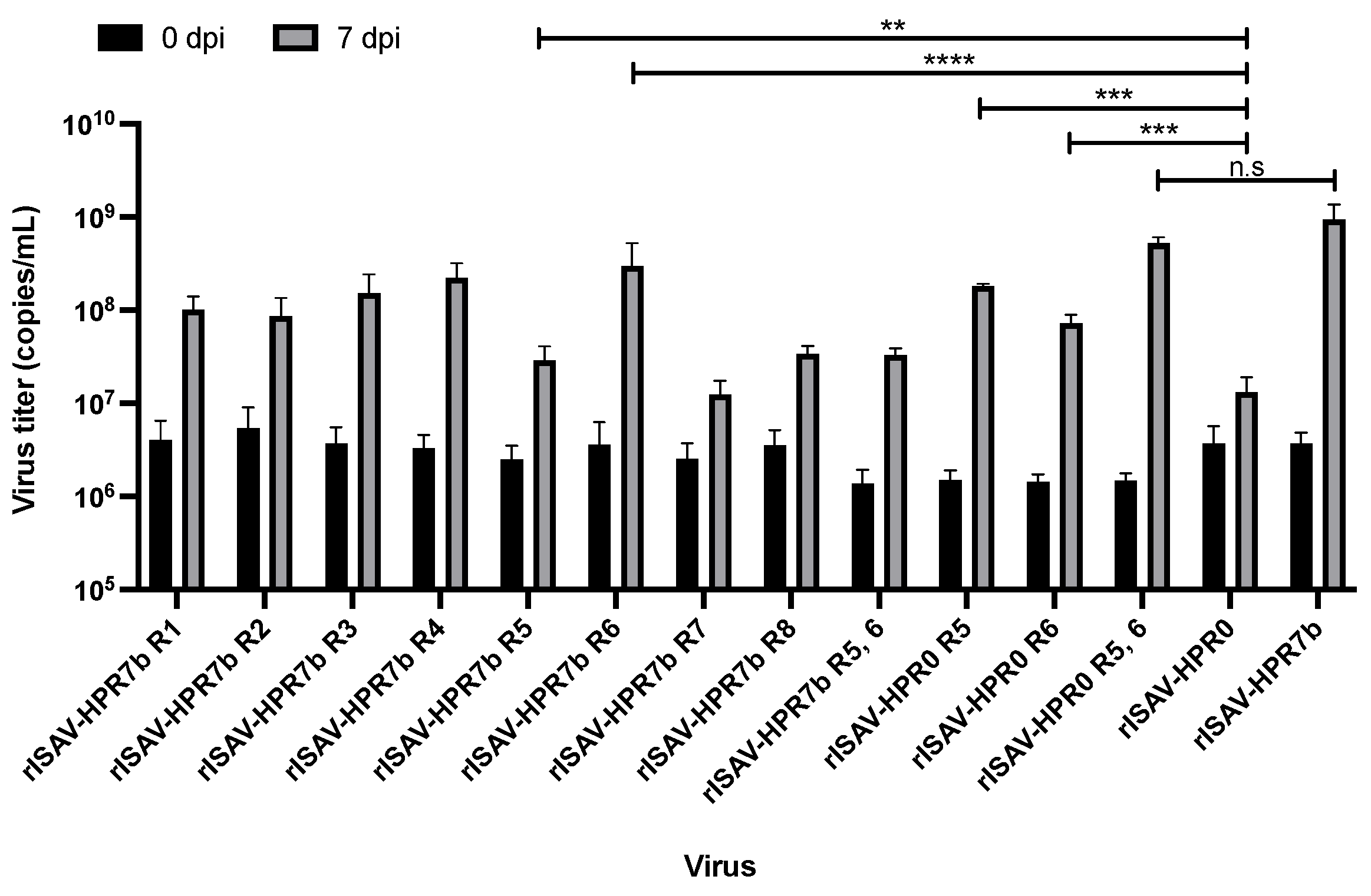
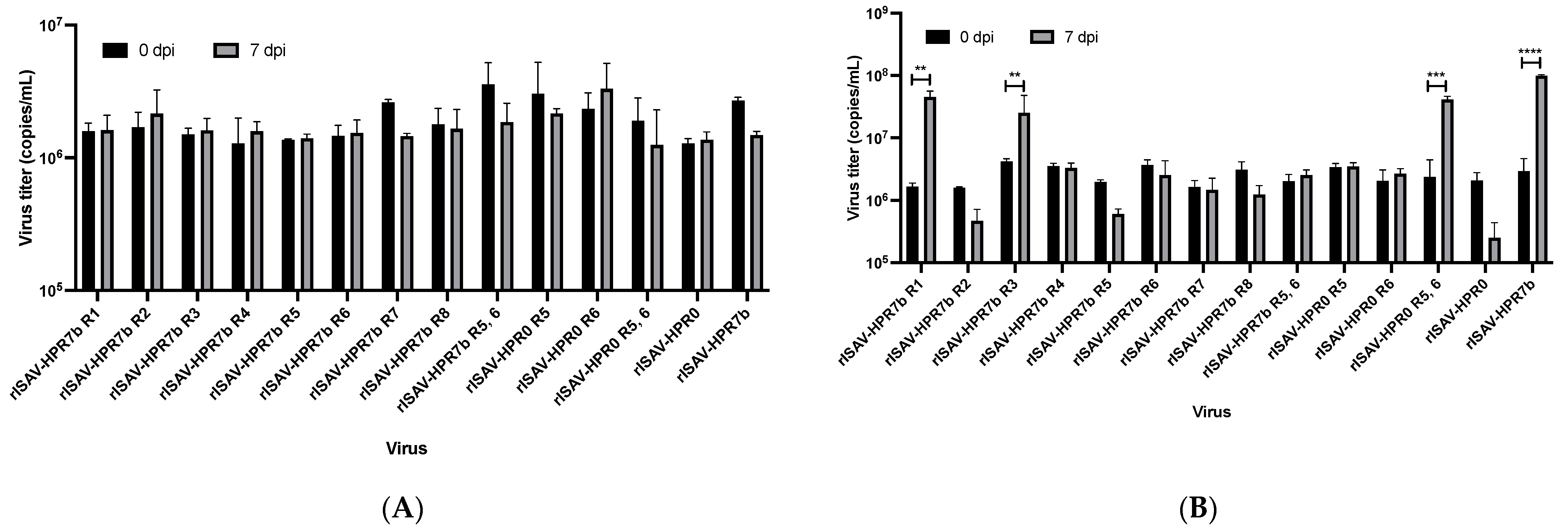

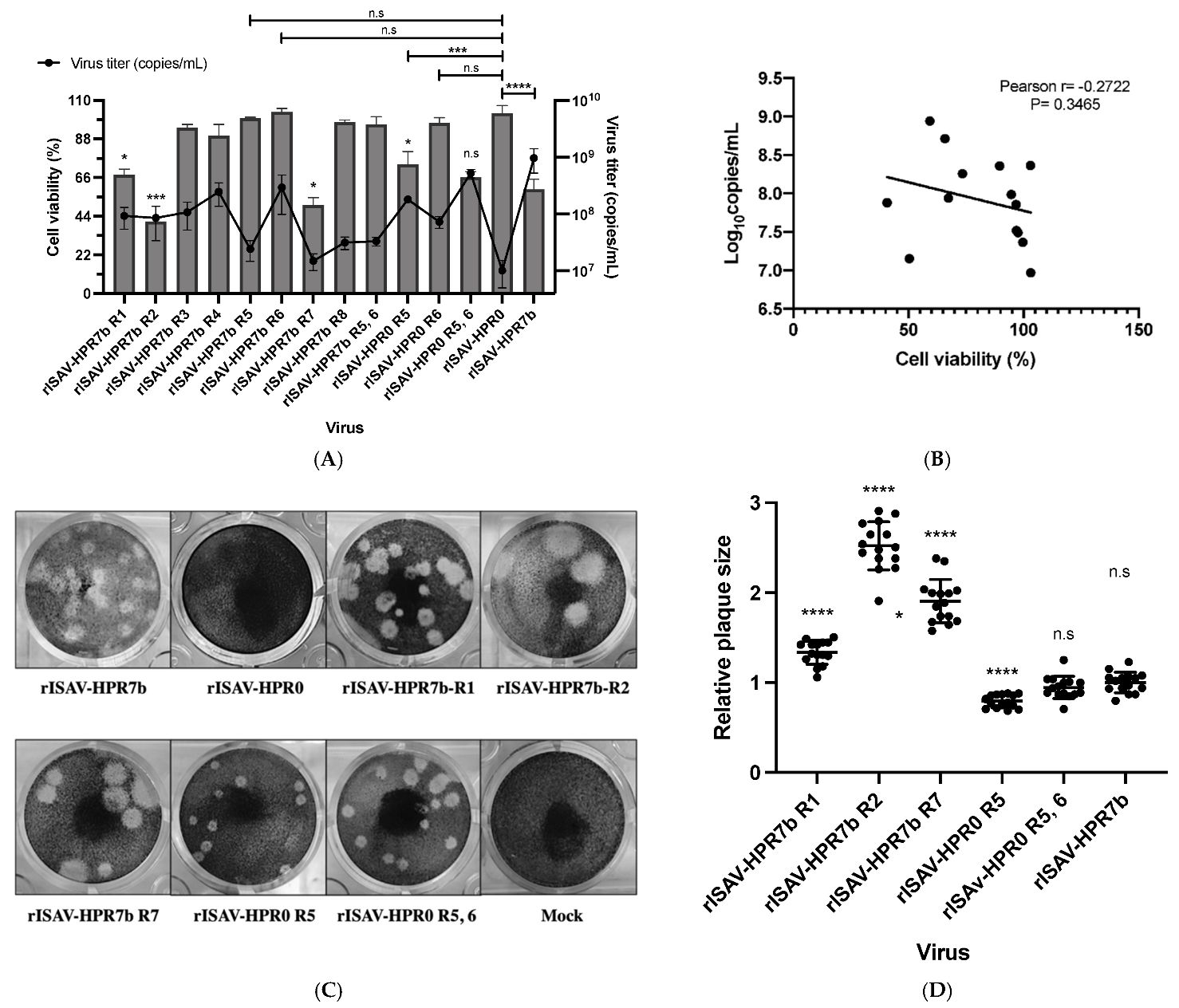
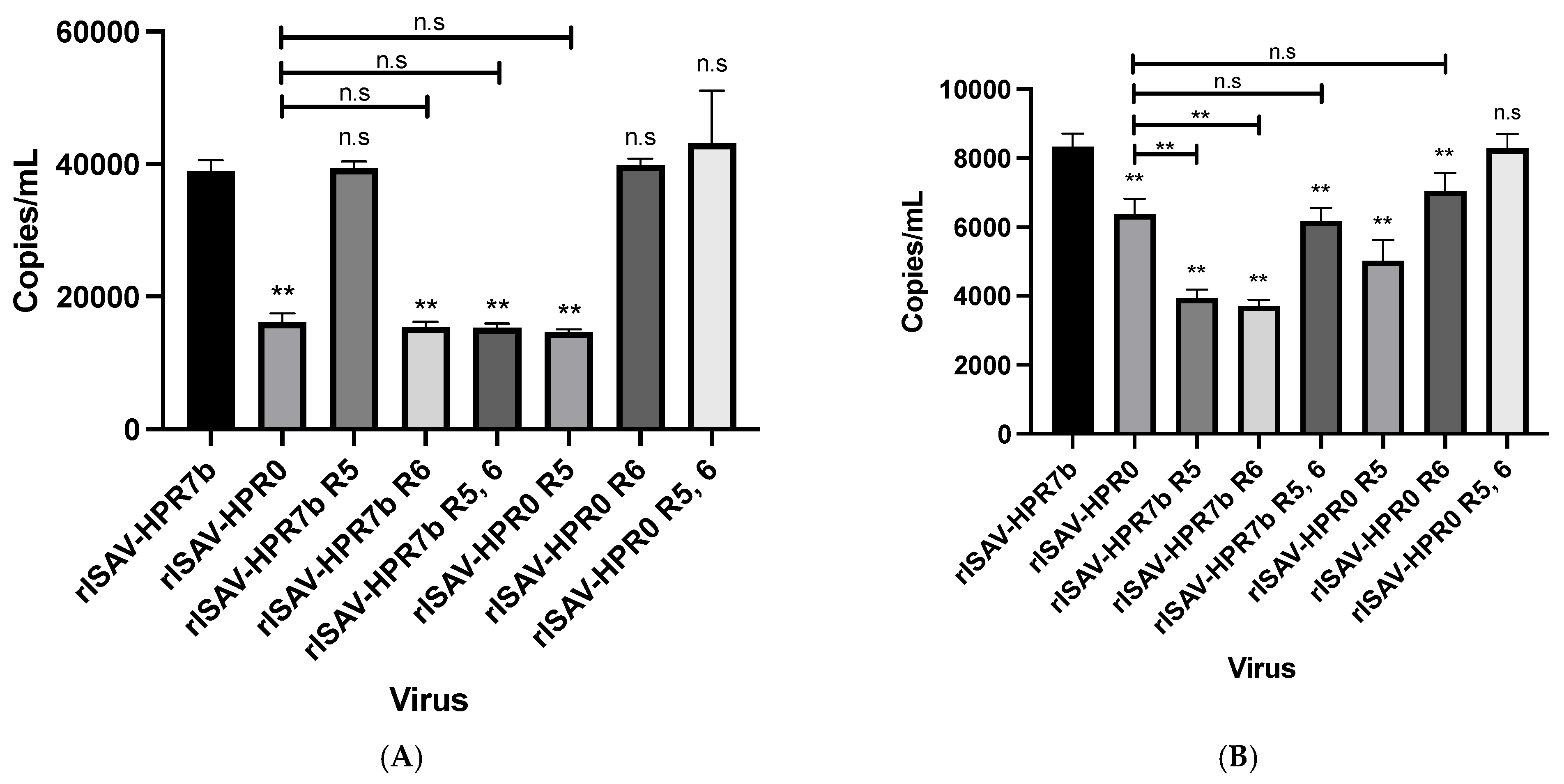
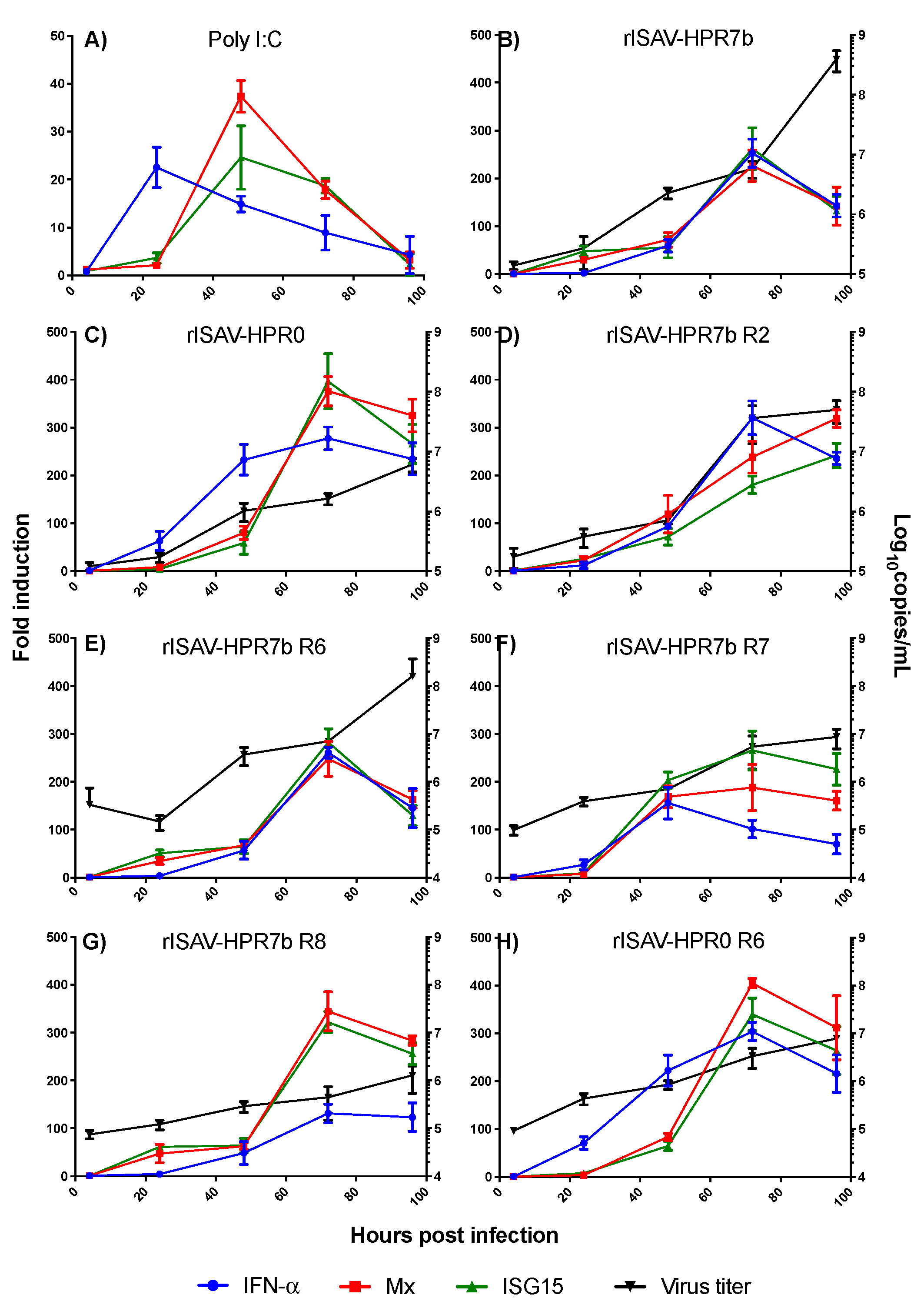
| Plasmid | Cloned Segment | Segment Genotype | GenBank Accesion Number |
|---|---|---|---|
| pSS-URG-S1/1 | 1 | HPR0 | EU118815 |
| pSS-URG-S2/1 | 2 | HPR0 | EU118816 |
| pSS-URG-S3/1 | 3 | HPR0 | EU118817 |
| pSS-URG-S4/1 | 4 | HPR0 | EU118818 |
| pSS-URG-S5/1 | 5 | HPR0 | EU118819 |
| pSS-URG-S6/1 | 6 | HPR0 | EU118820 |
| pSS-URG-S7/1 | 7 | HPR0 | EU118821 |
| pSS-URG-S8/1 | 8 | HPR0 | EU118822 |
| pSS-URG-S1/2 | 1 | HPR7b | GU830895 |
| pSS-URG-S2/2 | 2 | HPR7b | GU830896 |
| pSS-URG-S3/2 | 3 | HPR7b | GU830897 |
| pSS-URG-S4/2 | 4 | HPR7b | GU830898 |
| pSS-URG-S5/2 | 5 | HPR7b | GU830899 |
| pSS-URG-S6/2 | 6 | HPR7b | GU830900 |
| pSS-URG-S7/2 | 7 | HPR7b | GU830901 |
| pSS-URG-S8/2 | 8 | HPR7b | GU830902 |
| Segment | Name | Sequence | Reference |
|---|---|---|---|
| 1 | S1_Fw | CGGAACCAACTACCGAGGAG | This work |
| S1_Rv | GGGATCTCCTCCTGTTTCAACT | ||
| 2 | S2_Fw | TCAGGTGTATGCAGGGGAAAC | This work |
| S2_Rv | TGAAGGCCCTCCAAGGTACT | ||
| 3 | S3_Fw | GCTGCAGCAATCGAAAGGTC | This work |
| S3_Rv | CGTCTTCATCAGCCAAAGCG | ||
| 4 | S4_Fw | ACCAACGGGAAAGACAGAG | This work |
| S4_Rv | TCAAGCCTCTCAGTTCCCA | ||
| 5 | S5_Fw | CTGCGGAGGTACAACAGGTTA | This work |
| S5_Rv | CTGGTACAGAATGGAACGGCA | ||
| 6 | S6_Fw | GCCCAGACATTGACTGGAGATG | Cárdenas et al., 2020 [29] |
| S6_Rv | GATGGTGGAATTCTACCTCTAGACTTGTA | ||
| 7 | S7_Fw | TGTTTGTCACTGGCCCTGAG | This work |
| S7_Rv | TGAGCCCGACAGGAAAGAAG | ||
| 8 | S8_Fw | TGCTACTTACACTTGGCG | This work |
| S8_Rv | TCTGCATCCTGCTGTGTAGC |
| Gene | Name | Sequence | Reference |
|---|---|---|---|
| INF-α | Fw_IFN-α | GGACAAGAAAAACCTGGACG | Reyes-Cerpa et al., 2014 [36] |
| Rv_IFN-α | CTTTCCTGATGAGCTCCCAC | ||
| Mx | Fw_Mx | TGCAACCACAGAGGCTTTGAA | Haugland, Ø et al., 2005 [37] |
| Rv_Mx | GGCTTGGTCAGGATGCCTAAT | ||
| ISG15 | Fw_ISG15 | TGAAAAACGAAAAGGGCCAGAC | This work |
| Rv_ISG15 | CAGCCTCCCCTTAGACGGA | ||
| 18S | 18S_Fw | GCAAATGCTTTCGCTTTCG | Jorgensen, S et al., 2006 [34] |
| 18S_Rv | TGTGCCGCTAGAGGTGAAATT |
| Fold Induction | |||
|---|---|---|---|
| Virus | INF-α | ISG15 | Mx |
| HPR7b | 252.9 | 262.4 | 226.5 |
| HPR0 | 277.4 | 396.9 | 376 |
| HPR7b R2 | 320.4 | 180.5 | 238.3 |
| HPR7b R6 | 261.1 | 282.6 | 247.9 |
| HPR7b R7 | 155 | 265.7 | 188 |
| HPR7b R8 | 131.5 | 322.1 | 344.5 |
| HPR0 R6 | 304.2 | 339.6 | 404.8 |
Publisher’s Note: MDPI stays neutral with regard to jurisdictional claims in published maps and institutional affiliations. |
© 2022 by the authors. Licensee MDPI, Basel, Switzerland. This article is an open access article distributed under the terms and conditions of the Creative Commons Attribution (CC BY) license (https://creativecommons.org/licenses/by/4.0/).
Share and Cite
Cárdenas, M.; Michelson, S.; Pérez, D.R.; Montoya, M.; Toledo, J.; Vásquez-Martínez, Y.; Cortez-San Martin, M. Infectious Salmon Anemia Virus Infectivity Is Determined by Multiple Segments with an Important Contribution from Segment 5. Viruses 2022, 14, 631. https://doi.org/10.3390/v14030631
Cárdenas M, Michelson S, Pérez DR, Montoya M, Toledo J, Vásquez-Martínez Y, Cortez-San Martin M. Infectious Salmon Anemia Virus Infectivity Is Determined by Multiple Segments with an Important Contribution from Segment 5. Viruses. 2022; 14(3):631. https://doi.org/10.3390/v14030631
Chicago/Turabian StyleCárdenas, Matías, Sofía Michelson, Daniel R. Pérez, Margarita Montoya, Jorge Toledo, Yesseny Vásquez-Martínez, and Marcelo Cortez-San Martin. 2022. "Infectious Salmon Anemia Virus Infectivity Is Determined by Multiple Segments with an Important Contribution from Segment 5" Viruses 14, no. 3: 631. https://doi.org/10.3390/v14030631
APA StyleCárdenas, M., Michelson, S., Pérez, D. R., Montoya, M., Toledo, J., Vásquez-Martínez, Y., & Cortez-San Martin, M. (2022). Infectious Salmon Anemia Virus Infectivity Is Determined by Multiple Segments with an Important Contribution from Segment 5. Viruses, 14(3), 631. https://doi.org/10.3390/v14030631







